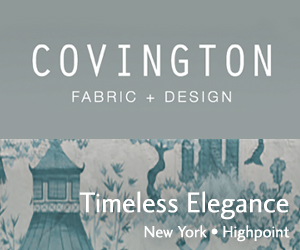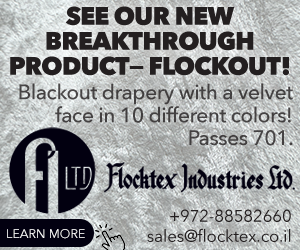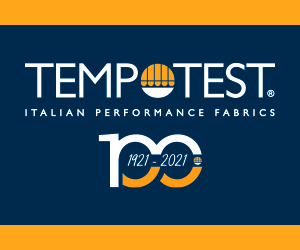Bru Textiles Opens New Warehouse, Offices in Kontich Belgium
August 13, 2002
Seven-Year-Old Converter, Owned by the Neiman Brothers, Reaches $25 Million in Sales
Kontich, Belgium — Since brothers Gary and Jason Neiman launched Bru Textiles (Decosit stand 9/A5-B67) in January 1995, they have built a profitable fabric converting business with $25 million in sales.
The joint presidents and equal owners of Bru opened a 20,000 square-foot, state-of-the-art warehouse in July and purchased extra land for future expansion. Bru had severely outgrown its previous facility (in the town of Mechelen, six miles away). In a matter of a week, the company moved one million meters of cloth to the new warehouse in Kontich. Bru produces deep color lines of organza, taffeta and plain cotton with "bright, freshly colored prints," said Gary, 35. "We started out by purchasing original designs from Stuart Graham in Port Elizabeth, South Africa. In a few years, Stuart was buying designs from us."
Gary and Jason's father is Selwyn Neiman, principal of Furnishing Fabrics Agencies in the U.K. Gary said that Bru buys some greige from FFA. He said their father taught them "about the business and good ethics."
Gary migrated from South Africa in 1989 and his parents left shortly after that. Initially, Gary represented P. Kaufmann, Richloom and Swavelle Mill Creek of the U.S.A., selling their lines in South Africa. He also represented the Belgian mill ITM in America.
In the meantime, Jason, 30, studied textile technology and management at Leeds University in the U.K.
Gary said that once a decorator uses a dramatic pattern he never uses it again. On the other hand, solid colors are used years. "Our niche is minimalist and features pure colors for the today's modern and trendy interiors," he said. "The consumer wants exclusivity. That's why solids work so well. The customer never gets tired of them.
"I'm not basing our whole business on solids; innovative designs are expected but at the end of the day, patterned goods generate sales of solids and generate the return on investment required to develop designs," Gary said The Bru line ranges from $2.50 to $22.50. It covers the entire spectrum of solid color in drapery, upholstery and multi-purpose fabric in piece dyes and yarn dyes. "Today, European manufacturers are all very competitive. We know our way around the cheap market, but we gravitate towards the best products available," Gary said.
The new facility embraces modern technology. It's equipped with 30-foot storage racks, a Web-based, paperless warehouse with wireless computers and scanners for keeping track of the inventoryand the orders.
"Initially, technology did not play a big part in our business but it sure does now," said Jason, who supervised the design of the proprietary software used to run the business. Each member of the warehouse crew uses an order picker guided by radio waves sent through the warehouse floor.
Jason also built a feature so that customers could get complete information online, including order tracking, delivery dates, accounting information and shipping details. The system runs on five in-house servers and has a protective firewall for a virtual private network. "If somebody comes along with a good machine to make us more efficient, we'll always buy it," Jason said.
"Our appetite for product is growing. Our energy and momentum to sell is growing. We have six core suppliers and no more than 12 in total. I want to be important to my suppliers but we're always ready to see a new line," Gary stressed.
"The most difficult problem we have is making our suppliers realize that the ultimate consumer does not accept the industry standard of five flaws per 50 meter roll. This becomes the converter's problem. We would rather not have this problem, but we understand that our suppliers do their best to deliver the highest quality product to us but it can never be good enough. The consumers' demand for quality has increased.
"We are capable of supporting 200,000 meters a week," Gary said.
"All that could be done, technically speaking, to run the business has been done to control the costs of doing business very efficiently," Jason said.
"Our only limitation is how much we can sell because our production capability is unlimited as a converter," Gary added. "We have all the systems in place to move an unlimited amount of goods. We build sales through merchandising programs with existing customers. Our goal is to make it difficult for them not to buy from Bru.
"That's the advantage of converting: We make what the market wants rather than what we can produce. We get a feel for what the market wants and then combine this with the best marketing and merchandising.
Gary handles 80 percent of the sales relationships with the customers. He visits them several times a year in two dozen countries. He is aided in this effort by Hans Helsen, who was his boss when Gary worked in a Belgian mill.
Bru is a slang word for brothers or slang for good friend in South Africa, the birthplace of these 'brus.' They have always been close to each other growing up. Their desks face each other in the office. Both boys have been European barefoot water ski champions and Gary is a sky diving instructor and sky surfer. F&FI
Kontich, Belgium — Since brothers Gary and Jason Neiman launched Bru Textiles (Decosit stand 9/A5-B67) in January 1995, they have built a profitable fabric converting business with $25 million in sales.
The joint presidents and equal owners of Bru opened a 20,000 square-foot, state-of-the-art warehouse in July and purchased extra land for future expansion. Bru had severely outgrown its previous facility (in the town of Mechelen, six miles away). In a matter of a week, the company moved one million meters of cloth to the new warehouse in Kontich. Bru produces deep color lines of organza, taffeta and plain cotton with "bright, freshly colored prints," said Gary, 35. "We started out by purchasing original designs from Stuart Graham in Port Elizabeth, South Africa. In a few years, Stuart was buying designs from us."
Gary and Jason's father is Selwyn Neiman, principal of Furnishing Fabrics Agencies in the U.K. Gary said that Bru buys some greige from FFA. He said their father taught them "about the business and good ethics."
Gary migrated from South Africa in 1989 and his parents left shortly after that. Initially, Gary represented P. Kaufmann, Richloom and Swavelle Mill Creek of the U.S.A., selling their lines in South Africa. He also represented the Belgian mill ITM in America.
In the meantime, Jason, 30, studied textile technology and management at Leeds University in the U.K.
Gary said that once a decorator uses a dramatic pattern he never uses it again. On the other hand, solid colors are used years. "Our niche is minimalist and features pure colors for the today's modern and trendy interiors," he said. "The consumer wants exclusivity. That's why solids work so well. The customer never gets tired of them.
"I'm not basing our whole business on solids; innovative designs are expected but at the end of the day, patterned goods generate sales of solids and generate the return on investment required to develop designs," Gary said The Bru line ranges from $2.50 to $22.50. It covers the entire spectrum of solid color in drapery, upholstery and multi-purpose fabric in piece dyes and yarn dyes. "Today, European manufacturers are all very competitive. We know our way around the cheap market, but we gravitate towards the best products available," Gary said.
The new facility embraces modern technology. It's equipped with 30-foot storage racks, a Web-based, paperless warehouse with wireless computers and scanners for keeping track of the inventoryand the orders.
"Initially, technology did not play a big part in our business but it sure does now," said Jason, who supervised the design of the proprietary software used to run the business. Each member of the warehouse crew uses an order picker guided by radio waves sent through the warehouse floor.
Jason also built a feature so that customers could get complete information online, including order tracking, delivery dates, accounting information and shipping details. The system runs on five in-house servers and has a protective firewall for a virtual private network. "If somebody comes along with a good machine to make us more efficient, we'll always buy it," Jason said.
"Our appetite for product is growing. Our energy and momentum to sell is growing. We have six core suppliers and no more than 12 in total. I want to be important to my suppliers but we're always ready to see a new line," Gary stressed.
"The most difficult problem we have is making our suppliers realize that the ultimate consumer does not accept the industry standard of five flaws per 50 meter roll. This becomes the converter's problem. We would rather not have this problem, but we understand that our suppliers do their best to deliver the highest quality product to us but it can never be good enough. The consumers' demand for quality has increased.
"We are capable of supporting 200,000 meters a week," Gary said.
"All that could be done, technically speaking, to run the business has been done to control the costs of doing business very efficiently," Jason said.
"Our only limitation is how much we can sell because our production capability is unlimited as a converter," Gary added. "We have all the systems in place to move an unlimited amount of goods. We build sales through merchandising programs with existing customers. Our goal is to make it difficult for them not to buy from Bru.
"That's the advantage of converting: We make what the market wants rather than what we can produce. We get a feel for what the market wants and then combine this with the best marketing and merchandising.
Gary handles 80 percent of the sales relationships with the customers. He visits them several times a year in two dozen countries. He is aided in this effort by Hans Helsen, who was his boss when Gary worked in a Belgian mill.
Bru is a slang word for brothers or slang for good friend in South Africa, the birthplace of these 'brus.' They have always been close to each other growing up. Their desks face each other in the office. Both boys have been European barefoot water ski champions and Gary is a sky diving instructor and sky surfer. F&FI
















